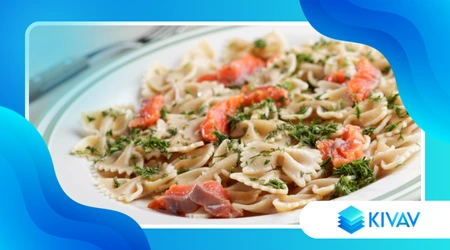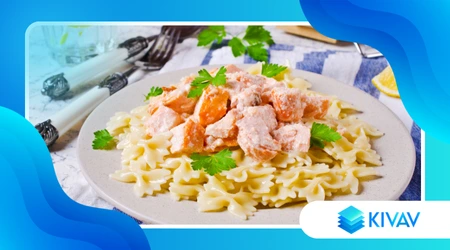Salmon and Cream Farfalle: Delicate and Quick

Italian cuisine is a perfect balance between tradition and innovation, and the farfalle with salmon and cream they represent this duality with mastery.
Announcements
A dish that combines the delicacy of fish with the richness of a creamy sauce, without requiring hours of cooking.
According to a recent survey by Coldiretti (2025), salmon is among the most consumed fish in Italian homes, appreciated for its versatility and nutritional profile.
But what makes this recipe so special?
It's not just the speed of execution, but the harmony between ingredients that, if treated with respect, create a gourmet experience accessible to all.
Announcements
1. Why are salmon and cream farfalle so popular?
In an era dominated by the meal prep and with a frenetic pace, this dish offers an illusion: that of having dedicated hours in the kitchen, when in reality 20 minutes are enough.
Its popularity has also grown thanks to its ease of customization. You can opt for a version light with vegetable cream, or enhance it with a sprinkling of caviar.
A practical example? Adding grated lemon zest at the last minute adds freshness, while a hint of chili pepper balances the sweetness of the salmon.
And if you think it's a modern dish, you're wrong.
The pairing of pasta and fish has its roots in coastal traditions, from Sicily to Liguria, although the cream version is a more recent reinterpretation.
2. The choice of ingredients: quality above all else
Salmon: fresh or smoked?
Fresh salmon, when cooked at a low temperature, maintains a buttery texture and releases its omega-3s.
++How to prepare basic Italian sauces
The smoked one, on the other hand, gives a more intense flavor and does not require cooking, just dissolve it in the sauce.
A chef's trick? Use both: the fresh one for the base and the smoked one for the garnish, creating contrast.
Cream: which type should I use?
Classic cooking cream (201g fat) is ideal for a velvety sauce that doesn't separate.
Those looking for an alternative can try soy cream, but be careful: it tends to be more liquid and requires a thickener like cornstarch.
Butterflies: the shape that makes the difference
Not all pasta is the same.
Farfalle, with their wings and grooves, capture sauce better than spaghetti or smooth penne.
For a more rustic version, you can use wholemeal or burnt wheat farfalle.
3. The perfect technique for a mistake-free sauce
The secret? The controlled temperature.
A shallot sauté should wilt, not burn. If it darkens too much, it will become bitter.
The white wine (a dry Sauvignon Blanc is perfect) should be reduced over high heat, but the cream should be added over low heat to avoid separation.
++How to make the perfect tomato sauce
A common mistake? Throwing the pasta in the water before finishing the sauce.
It's better to synchronize the times: when the sauce is almost ready, drain the farfalle al dente and sauté them in the sauce.
4. Smart pairings: from wine to vegetables
Wines that enhance the dish
A crisp Pinot Grigio contrasts the creaminess, while a well-structured Chardonnay enhances the richness.
For a different experience, try it with a Japanese green tea sencha, with a herbaceous aftertaste that cleanses the palate.
Side dishes that complete
Sautéed asparagus or a handful of raw spinach add crunch and color.
However, avoid vegetables that are too watery, such as tomatoes, which could make the dish soggy.

5. Creative variations to amaze your guests
For a summer version, replace the cream with Greek yogurt and add fresh mint.
In winter, a grating of nutmeg and a drizzle of brandy warm the palate.
Have you ever tried using honey and mustard marinated salmon?
It melts into the sauce, giving off unusual sweet and sour notes.
6. Preparation tricks that make the difference
A detail many people overlook? The right time to salt the pasta water.
Add salt only when the water is boiling, avoiding letting it evaporate before the pasta is immersed.
Another secret: set aside a glass of the cooking water before draining the farfalle.
This starchy liquid is essential for adjusting the creaminess of the sauce.
And never, I repeat never, rinse pasta after cooking – you would remove the very starch that helps bind the sauce.
7. The perfect balance of flavors
The art of this recipe lies in the harmony between three key elements:
- The natural sweetness of salmon
- The acidity of white wine
- The richness of cream
When one of these components prevails too much, the dish loses its charm.
Always taste the sauce before serving and adjust with:
- A pinch of whole sea salt if you lack depth
- A splash of Sicilian lemon if it's too strong
- A teaspoon of Dijon mustard for complexity
8. Presentation: you eat first with your eyes
The plating deserves particular attention.
I recommend arranging the farfalle in a spiral shape in the center of the dinner plate, with the salmon pieces clearly visible.
Complete with:
- Decorative cream filaments
- Micro leaves of rocket or watercress
- Pink salt flowers and freshly ground pink pepper
For a touch of luxury, grate some bottarga (dried mullet roe) just before serving.
9. Adaptations for specific diets
Low-carb version: replace the farfalle with zucchini “farfalle” thinly sliced with a mandolin.
For lactose intolerant people: use lactose-free cream or homemade cashew cream (soaked cashews and blended with water).
Vegetarian? Try the grilled shitake mushrooms instead of the salmon – they offer a umami similar.
10. Common Beginner Mistakes (and How to Avoid Them)
- Overcooking salmon will make it rubbery. It should be barely opaque on the outside and slightly pink on the inside.
- Use UHT cream: many brands contain thickeners that alter the final consistency.
- Pour cold wine directly from the refrigerator: the thermal shock can "break" the emulsion.
- Drain the pasta and let it dry: it should go directly from the pan into the sauce.
11. Historical and cultural curiosities
Did you know that the pasta and salmon pairing isn't traditionally Italian?
It was born in the 1980s, influenced by the trend of French nouvelle cuisine.
Farfalle (called “gravate” in Veneto) were originally served with butter and sage.
Today, the salmon version represents the globalization of cuisine – an Italian dish with Norwegian ingredients and French technique.
The recipe gained worldwide popularity after appearing on the menu of the “Il Pellicano” restaurant in Tuscany in 1992.
Final advice: To memorize the perfect sequence, remember the “3-2-1” rule:
3 minutes for the sauté
2 minutes to evaporate the wine
1 minute to incorporate the cream
Frequently Asked Questions (FAQ)
Can this dish be frozen?
Not recommended. The cream tends to separate and the salmon becomes rubbery.
What fish can replace salmon?
Salmon trout works well, as does diced fresh tuna.
How to prevent the sauce from becoming too thick?
Just add a ladle of the pasta cooking water, which is rich in starch, to lighten it.
Conclusion: a classic that never goes out of style
The farfalle with salmon and cream They are proof that quality cooking doesn't necessarily take time.
With the right ingredients and precise techniques, it transforms into a restaurant dish, suitable for a romantic dinner or a quick lunch.
Next time you think, “I don’t have time to cook well,” remember this recipe.
All it takes is a careful gesture, a well-chosen ingredient, and the table will be transformed.
